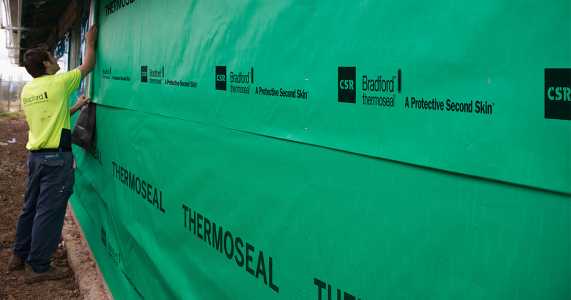Installation of wall wrap can help in reducing air-flow around insulation and through a cavity, allowing insulation to work more efficiently & effectively.
Benefits of using Wall Wraps:
- Reduction in Draughts: Wall Wraps reduce draught through wall frames and around wall insulation batts. Reducing air infiltration makes homes more comfortable and helps insulation work more efficiently.
- Reduction in Moisture: Bradford Wall Wraps can reduce moisture entry through walls, helping prevent structural damage to the frame and allowing wall insulation to perform at specified R-Value rating.
- Improving Energy Efficiency: Wall Wraps helps in improving building's energy efficiency by protecting wall insulation batts from draughts and moisture entry. R-Value rating of a wall can be improved if reflective face of Thermoseal Wall Wrap is placed beside an air gap.
Type 1 : Bradford Thermoseal Wall Wrap:
Thermoseal Wall Wrap is a durable medium duty weather barrier designed to improve your home's thermal performance and weather resistance. It also protects new builds from wind-driven rain and dust during construction.
- Serves as a tough weather barrier.
- Perfect for brick veneer walls.
- Suitable for BAL fire regions.

It is ideal for use in residential and commercial brick veneer construction but not recommended for lightweight clad.
Type 2: Bradford Enviroseal Wall Wrap
Enviroseal Proctor Wrap is a light duty vapour permeable wall wrap designed for use in residential timber and steel frame wall construction. It is a durable and lightweight textile membrane with a soft construction designed to allow moisture to escape from inside of the building.
- A tough weather barrier
- Minimises the risk of condensation related mold growth.
- Ideal for both brick veneer and all lightweight clad.
- Suitable for BAL fire regions.

Wall Wrap Selection Guide:
Selection of the most appropriate wall wrap depends on type of climate, type of construction and amount of wall insulation getting used.
The key variable is, that wall wrap should control moisture this involves controlling water vapours from both outside and inside the building. Selecting the on right wall wrap can also assist in maintaining energy efficiency, structural durability and occupant health. Below climate map can be used to select most appropriate wall wrap.
Hot & Humid (BCA Climate Zone 1) Typically hot & humid environments with warm winters predominately artificially cooled to manage internal humidity.
Temperate (BCA Climate Zones 2/3/4/5) Typically warm and less humid environments with cooler winters combination of some artificial cooling and heating with R1.5/R2.0 wall batts.
Cold (BCA Climate Zones 6/7/8) Typically cooler environments with cold winters predominately artificially heated with R2.5/R2.7 wall batts.
Standard ventilated brick veneer or lightweight clad wall assembly generally experience a loss in thermal performance of wall insulation simply due to air-flow through assembly, regardless of the type of insulation installed. This loss is a result of infiltration of air changing the temperature of air trapped around insulation, which in turn changes effectiveness of insulation. Installation of Bradford Wall Wraps, either permeable or non-permeable can help air-flow reduction around insulation and through cavity. Consideration of condensation management also plays an essential part in selection process based upon location and building design.
